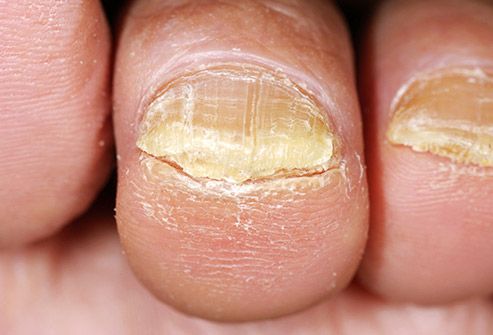Table of Contents
Nail Fungus is an infection of one or many nails. A nail is a hard and insensitive plate located on the back of the terminal phalanges of your fingers and toes. It is surrounded laterally by a fold of skin called the eponychium (also known as cuticle). In general, a healthy nail is semi-transparent. Near the root, it has a half-moon-shaped whitish color called lunula. This portion, in the form of half-moon, is covered by a portion of the cuticle.
 Besides physiological functions, your nails also play an aesthetic role. A good looking nail says a lot about you including your health and hygienic habit. Unfortunately, the beauty of the nail is sometimes disrupted by certain medical conditions, among which fungal infection (onychomycosis).
Besides physiological functions, your nails also play an aesthetic role. A good looking nail says a lot about you including your health and hygienic habit. Unfortunately, the beauty of the nail is sometimes disrupted by certain medical conditions, among which fungal infection (onychomycosis).
Fungal nail infection is a condition of the toenails or fingernails caused by fungi. These microorganisms grow on the nail and destroy it progressively. Nail fungus is the most common of nail diseases, affecting nearly 5% of the world’s population; about 20% of them are aged 40 to 60 years.
Nail Fungus Causes and Risk Factors
A Nail is a horn-like structure at the end of your fingers and toes. It is made of a tough protein called keratin. In spite of its solidity, overgrowth of fungi can damage or even destroy the nail. The major causative factors of fungal proliferation in your nail include: water, cold, aggressive manicures, detergents, certain solvents, allergic substances, and trauma. When your nails are overexposed to these agents, fungi, yeasts or molds tends to anarchically spread into them and damage them.
Fungi: The most common fungal infections affecting fingernails and toenails are caused by fungi known as dermatophytes. The infection causes the nail to change color, thicken, become distorted in shape, and sometimes detach from the nail bed. As the infection worsens, it may appear on the infected nail a green pigment resulting of a significant fungal colonization. The base of the finger/toe becomes red and painful. The infection can actually appear first in one nail and then extend to other nails.
The following are other common causes of nail fungus:
Cosmetic allergies: you may develop nail infection if you apply on your skin cosmetic products containing allergic substances. Those allergens can cause the nails to split into layers or have streaks or grooves. Sometimes, it can appear on the nails white, black or brown spots. In severe infection, the cuticle can become inflamed.
Drug Allergies: Those types of allergies can occur in the nails after consuming food or drugs containing allergenic substances. In this case, the nails will change color but not become painful. In addition, unlike infection caused by trauma, fungi or systemic diseases, the discoloration will disappear in a very short time period of time, or days after stop taking the drug.
Paronychia – Paronychia is an infection or inflammation developed in the soft tissue around your fingernail. It can be caused by yeast (fungal paronychia), bacteria (bacterial paronychia) or candida (candidal paronychia). It occurs when bacteria entering the skin around the nail. The infection is usually characterized by intense inflammation, swelling and pain, which can be associated with blisters, pustules or loss of the cuticles. Factors favoring the multiplication of the microorganisms are usually minimal injuries, habit of sucking the finger and aggressive manicures. The treatment is based on antiseptics, emollients and antibiotics.
Malnutrition – Although rare, lack of certain vitamins and minerals can affect your nails. When your nails damaged due to malnutrition, they tend to brittle, fragile, soft, lose their thickness and texture, and have spots of different colors.
Chemicals – The nails can be broken or split by trauma and chemical use such as alkaline detergents.
People at risk of nail fungus:
- Diabetics
- Syphilis patients
- Malnourished individuals
- Those who wear tight shoes or socks
- Those who work in humid areas
- Those whose occupation exposes their nails to injuries/trauma
- People who constantly wear nail polish
- AIDS/HIV patients
- Cancer patients that undergoing chemotherapy or/and radiotherapy
- People who have poor circulation to their feet.
Nail Fungus Symptoms
 Although some forms of psoriasis may produce similar symptoms, signs and symptoms of the infection of nail fungus are usually easy to be determined; you don’t need a medical specialist to tell you have fungal nail infection. In general, if you have nail fungus infection includes:
Although some forms of psoriasis may produce similar symptoms, signs and symptoms of the infection of nail fungus are usually easy to be determined; you don’t need a medical specialist to tell you have fungal nail infection. In general, if you have nail fungus infection includes:
- Brittleness
- Thickening
- Discoloration
- Change in the nail shape
- Crumbling of the nail
- Presence of debris trapped under the infected nail
- Detachment of the nail from the nail bed
- Loss of luster and shine
In addition, if you have onychomycosis, it may be difficult for you to walk when you wear shoes. If you are diabetic, the disease can lead to serious bone infections or ulcers in your feet. The infection can also cause a low self-esteem in you because of the appearance of your nail.
Nail Fungus Diagnosis
The diagnosis of the nail fungus infection is based mainly on the appearance of the nails. If symptoms of the disease are detected, your doctor may take a sample of the infected nail for mycological analysis. This sample is examined under a microscope to detect the causative microorganism responsible for the infection. It is important for your health care provider to know the cause on the infection to determine what type of treatment will be appropriate.
Nail Fungus Treatment (Medical)
To combat the infection, your doctor may prescribe you medications to take orally, or nail nail polish medications such as ciclopirox (Penlac) or amorolfine (or amorolfine).
Oral medication – depending on the severity of the infection, along with the nail vanish, your doctor may recommend you take drugs orally for several months. However, these drugs sometimes cause severe side effects, including liver damage; some people have to stop taking them. The most drugs used to treat infection of the nail fungus include:
- Itraconazole (Sporanox)
- Fluconazole (Diflucan)
- Terbinafine (Lamisil)
- ketoconazole (Nizoral)
- griseofulvin (Grifulvin V).
Other medications that can be used to inhibit the growth of fungi on your nail include: Sodium Pyrithione, imidazole and allylamine.
Nail Fungus treatment (Alternative)
Essential oil of melaleuca (melaleuca alternifolia) – topical application of pure oil of melaleuca two to three times a day can help effectively combat your nail fungus infection. However, treatment should be continued for at least six months.
Caution: melaleuca can trigger allergic reactions; it is advisable to first test it on a small area of skin before applying the oil on your complete nail.
Nail Fungus Prevention
The preventive treatment of nail fungus consists of a good hygiene:
- Cut your nails properly, and keep it clean and short
- Do not wear too tight shoes and socks
- Avoid wearing nail polish or artificial nails
- Wear rubber gloves if you work in areas that can injure your nail
- Do not cut the skin around your nails if it is not necessary
- Do not exercise any pressure on your nails during manicure or pedicure
- Treat all problems of your nails early
- Some nail diseases are infectious; wash your hands after touching an infected nail
- Avoid your nails to detergent products, bad cosmetics, allergic substances, and trauma.
In addition, Your nail may also be affected by the following conditions:
Onychosis is any disease or deformity of the nails; it may be caused by many factors such as fungus, bacterial, injury or trauma, and chemotherapy.
Onychia – inflammation of the matrix of a nail often leading to suppuration and loss of the nail
Paronychia – inflammation of the tissues adjacent to the nail of a finger or toe usually accompanied by infection and pus formation
Koilonychia (spoon nails) – abnormal thinness and concavity of fingernails occurring especially in hypochromic anemia, abnormal paleness of the red blood cells.
Onycholysis – a loosening of a nail from the nail bed
Onychoptosis – progressive shedding of part or all of a nail
Onychogryposis – an abnormal condition of the fingernails or toenails characterized by enlargement and increased thickening and curvature
Onychomadesis – Complete shedding of a fingernail or toenail, usually associated with a systemic illness
Onychocryptosis – an ingrown toenail
Onychodystrophy – dystrophic changes in fingernails or toenails, such as malformation or discoloration, occurring due a congenital defect or due to illness or injury
Subungual hematoma – a collection of blood (hematoma) underneath a toenail or fingernail.



